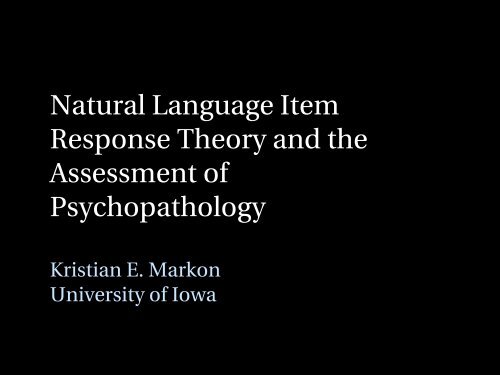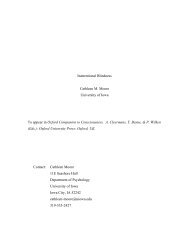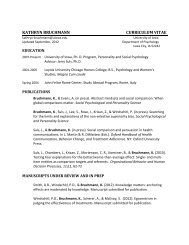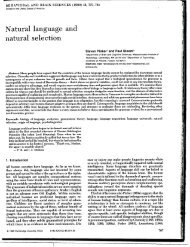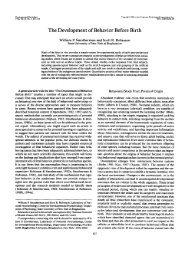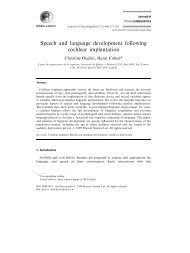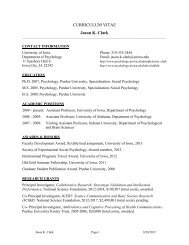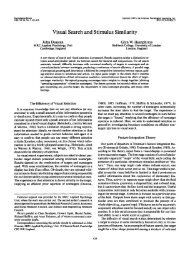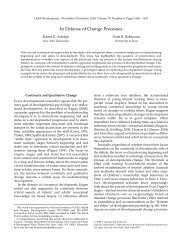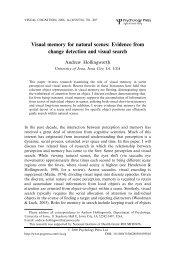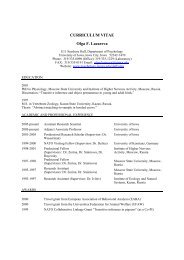Natural Language Item Response Theory and ... - University of Iowa
Natural Language Item Response Theory and ... - University of Iowa
Natural Language Item Response Theory and ... - University of Iowa
- No tags were found...
Create successful ePaper yourself
Turn your PDF publications into a flip-book with our unique Google optimized e-Paper software.
<strong>Natural</strong> <strong>Language</strong> <strong>Item</strong><strong>Response</strong> <strong>Theory</strong> <strong>and</strong> theAssessment <strong>of</strong>PsychopathologyKristian E. Markon<strong>University</strong> <strong>of</strong> <strong>Iowa</strong>
Assessment <strong>of</strong> Psychopathology <strong>and</strong><strong>Response</strong> Format●●Most tests <strong>and</strong> inventories use structuredresponse format● e.g., Likert (“true-false”, “1-5”)●structured interviewSimplifies quantification, but has limitations●●can be awkward, restrictiveresponse meaning can be ambiguous
Assessment <strong>of</strong> Psychopathology <strong>and</strong><strong>Response</strong> Format●●One possibility is to use natural language (i.e.,free) format responses●●more flexible“information-rich”Quantification <strong>of</strong> such responses is expensive,however●●generally requires ratersraters may require training, etc.
<strong>Natural</strong> <strong>Language</strong> <strong>Item</strong> <strong>Response</strong><strong>Theory</strong> (NLIRT)●Incredible progress in statistical modeling <strong>of</strong>natural language data; e.g.,●spam filters● text classification (e.g., Blei, Ng, & Jordan, 2003)●●essay scoringThese methods can be used to develop naturallanguage item response theory (NLIRT)
<strong>Natural</strong> <strong>Language</strong> <strong>Item</strong> <strong>Response</strong><strong>Theory</strong> (NLIRT)●●NLIRT is like other types <strong>of</strong> item responsetheory:●●●provides statistical model <strong>of</strong> item responsequantifies measurement properties <strong>of</strong> itemsallows one to assign scores to individualsUnlike other forms <strong>of</strong> item response theory, isfocused on natural language responses
Statistical Modeling <strong>of</strong> <strong>Natural</strong><strong>Language</strong> Data●●Statistical modeling <strong>of</strong> natural language datacomprises two basic steps:●●tokenization—process <strong>of</strong> creating tokensmodeling—modeling <strong>of</strong> tokensBasically, breaking natural language responsesinto “modelable units”, <strong>and</strong> then modelingthem
What are some things you’vedone that have been especiallyirresponsible?
<strong>Natural</strong> <strong>Language</strong> <strong>Item</strong> <strong>Response</strong>Model●●●Like other IRT models, model probability <strong>of</strong>each response as function <strong>of</strong> underlying traitIn NLIRT, response is token (e.g., word)Underlying trait is unobserved, latent●●inferred from patterns <strong>of</strong> responses acrossitemssingle trait underlies responses to items
<strong>Natural</strong> <strong>Language</strong> <strong>Item</strong> <strong>Response</strong>Model●●For each item, model has two parameters foreach response (i.e., each token in vocabulary):●●discrimination (a)—how informative?severity (b)—where is it informative?Very similar to nominal response model forpolychotomous data
<strong>Natural</strong> <strong>Language</strong> <strong>Item</strong> <strong>Response</strong>Model●●Probability <strong>of</strong> a particular token being used isfunction <strong>of</strong> latent trait (θ) <strong>and</strong> token discrimination(a) <strong>and</strong> severity (b)Equal to the percent <strong>of</strong> the “propensity space”represented by that particular response.P w i ∣=expa i b i ∑ iexpa i b i = Propensity to use w iTotal propensity
<strong>Natural</strong> <strong>Language</strong> <strong>Item</strong> <strong>Response</strong>Model●●Probability <strong>of</strong> a particular token being used isfunction <strong>of</strong> latent trait (θ) <strong>and</strong> token discrimination(a) <strong>and</strong> severity (b)Equal to the percent <strong>of</strong> the “propensity space”represented by that particular response.P w i ∣=expa i b i ∑ iexpa i b i = Propensity to use w iTotal propensity
<strong>Natural</strong> <strong>Language</strong> <strong>Item</strong> <strong>Response</strong>Model●●Probability <strong>of</strong> a particular token being used isfunction <strong>of</strong> latent trait (θ) <strong>and</strong> token discrimination(a) <strong>and</strong> severity (b)Equal to the percent <strong>of</strong> the “propensity space”represented by that particular response.P w i ∣=expa i b i ∑ iexpa i b i = Propensity to use w iTotal propensity
Example <strong>Response</strong>s (θ = -1.06)Describe times you’ve had problems with thelaw:“Never.”What are some things you’ve done that havebeen especially irresponsible?“Not turning in homework assignments on time.”
Example <strong>Response</strong>s (θ = 1.12)Describe times you’ve had problems with thelaw:“I stole a case <strong>of</strong> beer ... got an OWI, got arrested fordriving without a license, noise complaints.”What are some things you’ve done that havebeen especially irresponsible?“Drinking <strong>and</strong> driving, having my [family] see mecome home drunk”
Criterion-Related ValidityScale r pBFIExtraversion -.07 .65Agreeableness -.32 .02Conscientiousness -.26 .05Neuroticism -.07 .67Openness .22 .18ESI .44 .01IDAS -.10 .72
Psychometric Insights Provided byNLIRT●●●Psychometrically, natural language items arelike testlets or “mini-tests”Also like items that you can respond to anindefinite number <strong>of</strong> timesEvaluating natural language items may requireconcepts like item reliability
Summary <strong>and</strong> Future Directions●●Developing <strong>and</strong> using psychometrics <strong>of</strong>natural language response items is feasibleMuch work to be done:●●●●more complex tokenshow to evaluate items, modelsrefining scoring, quantification <strong>of</strong>measurement errorjoint use with fixed-format items


